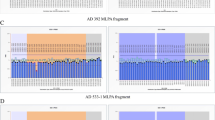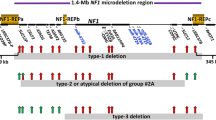Abstract
Tuberous sclerosis (TSC) is an autosomal dominant disorder caused by mutations in either of two genes, TSC1 and TSC2. Point mutations and small indels account for most TSC1 and TSC2 mutations. We examined 261 TSC DNA samples (209 small-mutation-negative and 52 unscreened) for large deletion/duplication mutations using multiplex ligation-dependent probe amplification (MLPA) probe sets designed to permit interrogation of all TSC1/2 exons, as well as 15–50 kb of flanking sequence. Large deletion/duplication mutations in TSC1 and TSC2 were identified in 54 patients, of which 50 were in TSC2, and 4 were in TSC1. All but two mutations were deletions. Only 13 deletions were intragenic in TSC2, and one in TSC1, so that 39 (73%) deletions extended beyond the 5′, 3′ or both ends of TSC1 or TSC2. Mutations were identified in 24% of small-mutation-negative and 8% of unscreened samples. Eight of 54 (15%) mutations were mosaic, affecting 34–62% of cells. All intragenic mutations were confirmed by LR-PCR. Genotype/phenotype analysis showed that all (21 of 21) patients with TSC2 deletions extending 3′ into the PKD1 gene had kidney cysts. Breakpoints of intragenic deletions were randomly distributed along the TSC2 sequence, and did not preferentially involve repeat sequence elements. Our own 20-plex probe sets gave more robust performance than the 40-plex probe sets from MRC-Holland. We conclude that large deletions in TSC1 and TSC2 account for about 0.5 and 6% of mutations seen in TSC patients, respectively, and MLPA is a highly sensitive and accurate detection method, including for mosaicism.




Similar content being viewed by others
References
Albertini AM, Hofer M, Calos MP, Miller JH (1982) On the formation of spontaneous deletions: the importance of short sequence homologies in the generation of large deletions. Cell 29:319–328
Au KS, Rodriguez JA, Rodriguez E Jr, Dobyns WB, Delgado MR, Northrup H (1997) Mutations and polymorphisms in the tuberous sclerosis complex gene on chromosome 16. Hum Mutat 9:23–29
Bedell JA, Korf I, Gish W (2000) MaskerAid: a performance enhancement to RepeatMasker. Bioinformatics 16:1040–1041
Benjamini Y, Hochberg Y (1995) Controlling the false discovery rate: a practical and powerful approach to multiple testing. J R Stat Soc B 57:289–300
Brook-Carter PT, Peral B, Ward CJ, Thompson P, Hughes J, Maheshwar MM, Nellist M, Gamble V, Harris PC, Sampson JR (1994) Deletion of the TSC2 and PKD1 genes associated with severe infantile polycystic kidney disease- a contiguous gene syndrome. Nat Genet 8:328–332
Consortium TEcts (1993) Identification and characterization of the tuberous sclerosis gene on chromosome 16. Cell 75:1305–1315
Curatolo P (2003) Tuberous sclerosis complex: from basic science to clinical phenotypes. Mac Keith Press, Cambridge
Dabora SL, Jozwiak S, Franz DN, Roberts PS, Nieto A, Chung J, Choy YS, Reeve MP, Thiele E, Egelhoff JC, Kasprzyk-Obara J, Domanska-Pakiela D, Kwiatkowski DJ (2001) Mutational analysis in a cohort of 224 tuberous sclerosis patients indicates increased severity of TSC2, compared with TSC1, disease in multiple organs. Am J Hum Genet 68:64–80
Dabora SL, Nieto AA, Franz D, Jozwiak S, Van Den Ouweland A, Kwiatkowski DJ (2000) Characterisation of six large deletions in TSC2 identified using long range PCR suggests diverse mechanisms including alu mediated recombination. J Med Genet 37:877–883
Ferec C, Casals T, Chuzhanova N, Macek M Jr, Bienvenu T, Holubova A, King C, McDevitt T, Castellani C, Farrell PM, Sheridan M, Pantaleo SJ, Loumi O, Messaoud T, Cuppens H, Torricelli F, Cutting GR, Williamson R, Ramos MJ, Pignatti PF, Raguenes O, Cooper DN, Audrezet MP, Chen JM (2006) Gross genomic rearrangements involving deletions in the CFTR gene: characterization of six new events from a large cohort of hitherto unidentified cystic fibrosis chromosomes and meta-analysis of the underlying mechanisms. Eur J Hum Genet 14:567–576
Gomez M, Sampson J, Whittemore V (1999) The tuberous sclerosis complex, 3rd edn. Oxford University Press, Oxford, UK
Imai K, Sarker AH, Akiyama K, Ikeda S, Yao M, Tsutsui K, Shohmori T, Seki S (1998) Genomic structure and sequence of a human homologue (NTHL1/NTH1) of Escherichia coli endonuclease III with those of the adjacent parts of TSC2 and SLC9A3R2 genes. Gene 222:287–295
Jones AC, Shyamsundar MM, Thomas MW, Maynard J, Idziaszczyk S, Tomkins S, Sampson JR, Cheadle JP (1999) Comprehensive mutation analysis of TSC1 and TSC2-and phenotypic correlations in 150 families with tuberous sclerosis. Am J Hum Genet 64:1305–1315
Kwiatkowski DJ (2004) TSC1 and TSC2 and tuberous sclerosis. In: Epstein CJ, Erickson RP, Wynshaw-Boris A (eds) Inborn errors of development. Oxford University Press, New York, pp 910–919
Langkau N, Martin N, Brandt R, Zugge K, Quast S, Wiegele G, Jauch A, Rehm M, Kuhl A, Mack-Vetter M, Zimmerhackl B, Janssen B (2002) TSC1 and TSC2 mutations in tuberous sclerosis, the associated phenotypes and a model to explain observed TSC1/ TSC2 frequency ratios. Eur J Pediatr 161:393–402
Longa L, Saluto A, Brusco A, Polidoro S, Padovan S, Allavena A, Carbonara C, Grosso E, Migone N (2001) TSC1 and TSC2 deletions differ in size, preference for recombinatorial sequences, and location within the gene. Hum Genet 108:156–166
Martignoni G, Bonetti F, Pea M, Tardanico R, Brunelli M, Eble JN (2002) Renal disease in adults with TSC2/PKD1 contiguous gene syndrome. Am J Surg Pathol 26:198–205
Matsumoto M, Nishimura T (1998) Mersenne Twister: a 623-dimensionally equidistributed uniform pseudorandom number generator. ACM Trans Model Comput Simul 8:3–30
Mazoyer S (2005) Genomic rearrangements in the BRCA1 and BRCA2 genes. Hum Mutat 25:415–422
Myers S, Bottolo L, Freeman C, McVean G, Donnelly P (2005) A fine-scale map of recombination rates and hotspots across the human genome. Science 310:321–324
Nellist M, Sancak O, Goedbloed MA, van Veghel-Plandsoen M, Maat-Kievit A, Lindhout D, Eussen BH, de Klein A, Halley DJ, van den Ouweland AM (2005) Large deletion at the TSC1 locus in a family with tuberous sclerosis complex. Genet Test 9:226–230
Osborne JP, Fryer A, Webb D (1991) Epidemiology of tuberous sclerosis. Ann N Y Acad Sci 615:125–127
Patel HP, Lu L, Blaszak RT, Bissler JJ (2004) PKD1 intron 21: triplex DNA formation and effect on replication. Nucleic Acids Res 32:1460–1468
Sampson JR, Maheshwar MM, Aspinwall R, Thompson P, Cheadle JP, Ravine D, Roy S, Haan E, Bernstein J, Harris PC (1997) Renal cystic disease in tuberous sclerosis: role of the polycystic kidney disease 1 gene. Am J Hum Genet 61:843–851
Sancak O, Nellist M, Goedbloed M, Elfferich P, Wouters C, Maat-Kievit A, Zonnenberg B, Verhoef S, Halley D, van den Ouweland A (2005) Mutational analysis of the TSC1 and TSC2 genes in a diagnostic setting: genotype—phenotype correlations and comparison of diagnostic DNA techniques in tuberous sclerosis complex. Eur J Hum Genet 13:731–741
Schouten JP, McElgunn CJ, Waaijer R, Zwijnenburg D, Diepvens F, Pals G (2002) Relative quantification of 40 nucleic acid sequences by multiplex ligation-dependent probe amplification. Nucleic Acids Res 30:e57
Shaw CJ, Lupski JR (2004) Implications of human genome architecture for rearrangement-based disorders: the genomic basis of disease. Hum Mol Genet 13(Spec No 1):R57–R64
van Slegtenhorst M, de Hoogt R, Hermans C, Nellist M, Janssen B, Verhoef S, Lindhout D, van den Ouweland A, Halley D, Young J, Burley M, Jeremiah S, Woodward K, Nahmias J, Fox M, Ekong R, Osborne J, Wolfe J, Povey S, Snell RG, Cheadle JP, Jones AC, Tachataki M, Ravine D, Kwiatkowski DJ (1997) Identification of the tuberous sclerosis gene TSC1 on chromosome 9q34. Science 277:805–808
Wimmer K, Yao S, Claes K, Kehrer-Sawatzki H, Tinschert S, De Raedt T, Legius E, Callens T, Beiglbock H, Maertens O, Messiaen L (2006) Spectrum of single and multiexon NF1 copy number changes in a cohort of 1,100 unselected NF1 patients. Genes Chromosomes Cancer 45:265–276
Acknowledgments
We thank all of the patients and clinicians who contributed DNA samples and clinical information; Mei Lin and Dawn Ciulla for assistance with capillary electrophoresis and peak height determinations; NIH NS31535 for support.
Author information
Authors and Affiliations
Corresponding author
Electronic supplementary material
Below is the link to the electronic supplementary material.
Fig5
Supplementary Figure 1. Electropherograms of MRC-Holland and homemade MLPA probe sets. Control samples are shown. The location of each probe within the gene is shown (e – exons, 5′ and 3′ – flanking sequences), while for control probes the size of the amplified product is shown (in bp). The size of amplified probes are 136-418 and 130-481 for the MRC-Holland probe sets, and 90-148 and 90-156 for the homemade probe sets. The asterisk indicates a probe whose signal was variable due to polymorphism and was not used for analysis. The view windows of the electropherograms were adjusted to permit better display of these patterns, which is why the width of peaks is different on the different electropherograms. Note the relative high range of peak size (4.7-5.2-fold) for the MRC-Holland probe sets in comparison to our homemade probe sets (2.0-fold). (TIF 1,385 kb)
Rights and permissions
About this article
Cite this article
Kozlowski, P., Roberts, P., Dabora, S. et al. Identification of 54 large deletions/duplications in TSC1 and TSC2 using MLPA, and genotype-phenotype correlations. Hum Genet 121, 389–400 (2007). https://doi.org/10.1007/s00439-006-0308-9
Received:
Accepted:
Published:
Issue Date:
DOI: https://doi.org/10.1007/s00439-006-0308-9




